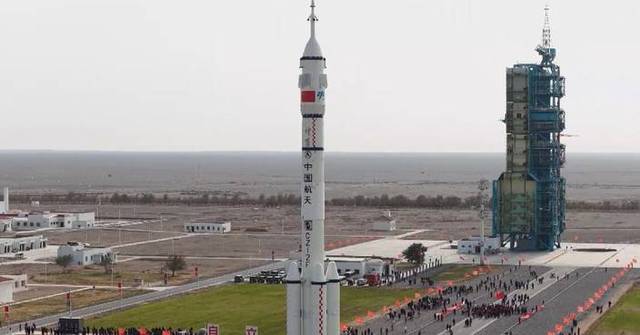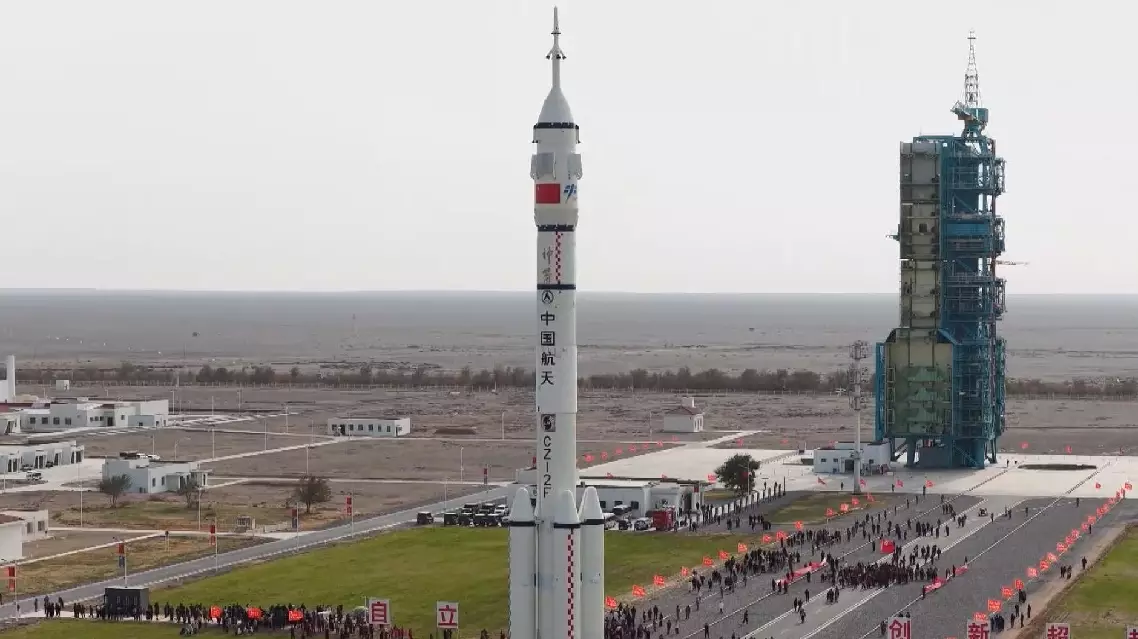An engineer from China’s upcoming Shenzhou-21 crewed mission on Friday explained the details and challenges involved in transferring the spaceship-rocket combination.
The combination of the Shenzhou-21 spaceship and its Long March-2F carrier rocket was transferred to the launch area of the Jiuquan Satellite Launch Center in northwest China on Friday morning, as the country prepares to send another crew to its orbiting space station.
Carried by a mobile launch platform, the combination moved along 1.5 km of seamless rail toward the launch tower from the testing facility.
Forty-eight hours prior to the transfer, an emergency repair team conducted a final status check on the mechanical structure and electrical systems of the testing facility’s gate to ensure the transfer proceeded as scheduled.
On Friday morning, the eastern gate of the testing facility slowly rose, revealing the Shenzhou-21 spaceship-rocket combination inside. The entire gate-opening process took over 30 minutes.
“Each section of the gate at the vertical testing facility weighs approximately 20 tons and is operated by a hoist on the top floor. The hoist pulls each section upward via steel cables attached to fixed pulleys. The two lower sections on the left and right act as sliding gates,” said engineer Wang Ming.
Once the 70-meter-tall gate had fully opened, the spaceship-rocket combination was slowly rolled out by the mobile launch platform. It then stopped in front of the gate and remained stationary for about half an hour.
“It remained stationary after being pushed out primarily to allow the power supply vehicle to reposition. Initially, the vehicle was positioned at the side of the platform far from the test facility, and during the stop, it moved to the opposite side to ensure uninterrupted power supply to the launch platform,” Wang explained to a reporter.
The spaceship-rocket combination then began its slow approach to the launch tower. But before rolling onto the 1.5-kilometer-long seamless steel track, it still had to overcome a few minor difficulties.
“The tracks that the combination was initially moving on were disconnected from the seamless rails ahead. There was a slight gap between them, which could cause minor vibrations for the mobile launch platform. Due to the substantial combined weight of the platform and the rocket, there could be some friction and wear between the wheels and the rails,” said Wang.
“This has virtually no impact on the rocket, as we conduct maintenance inspections and status checks before each transfer, and we provide robust safeguards to ensure everything proceeds smoothly,” he added.
The reason the seamless rails do not extend all the way into the testing facility is the facility’s unique structure. The facility has two compartments: one for the spaceship-rocket combination in the east and one for a backup rocket in the west.
Transfer vehicles in the blue area near the testing facility can move the rocket between the two sections.
“This is called a rail switch vehicle. It is primarily used to reposition the rocket between the eastern and western compartments as needed. After exiting the western section, the rocket is placed onto the transfer vehicle, which then moves it to the corresponding position in the eastern section, allowing the launch platform to enter the area,” said the engineer.
The use of switch vehicles ensures that backup rockets stored in the western section can be rapidly integrated into test and launch procedures, while maintaining the independent functionality of both compartments. This design improves the emergency response capability and operational stability of manned launch operations.
The Shenzhou-21 will be the 10th crewed mission since China began the initial construction of its space station and the sixth one since the space station entered the stage of application and development.
According to the schedule, the Shenzhou-21 crewed spacecraft is set to launch at an appropriate time in the coming days.
The Shenzhou-21 crew will replace the astronauts of the Shenzhou-20 mission, who have been in orbit for six months.
Engineer unveils complex transfer of Shenzhou-21 spaceship-rocket combo to launch site
Patrick Herminie was sworn in as the sixth president of the Republic of Seychelles on Sunday in the capital city of Victoria.
During his inauguration, Herminie vowed to unite the nation, improve the quality of life for citizens through pragmatic policies, and pursue a path of sustainable development for the island nation.
A seasoned public servant and former medical doctor, the 62-year-old Herminie won the presidency in the second round of voting, as announced by the Electoral Commission of Seychelles on October 12. Representing the United Seychelles Party, Herminie previously served as speaker of the National Assembly from 2007 to 2016.
Patrick Herminie sworn in as Seychelles’ new president



